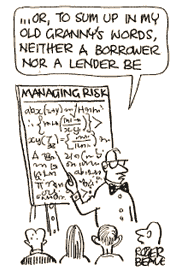Risk management should be handled with care
Roula Khalaf, Editor of the FT, selects her favourite stories in this weekly newsletter.
In the wake of the credit crisis, the teaching of risk management has become hugely controversial. Many blame the crisis on the failure of the mathematical modelling of market risk. This poses a significant challenge for the financial services industry and for business schools – can risk management be effectively taught, and which models should be used?
One of the problems is that the number of variables and degree of uncertainty in real markets is so considerable that modelling becomes highly complex. The approach often varies from institution to institution and even regulators have struggled to follow the methods used.
Some models have claimed an exaggerated degree of precision, while others have been overseen by people with insufficient training and experience. Many MBA courses have taught financial risk models as part of their curriculums but I would argue that the teaching of risk management is a specialism in its own right. Business schools have allowed too many MBA graduates to be let loose in the markets using formulas that they have not had the time, or the mathematical expertise, to understand fully.
In some cases, the models themselves were at fault. Some formulas for calculating the “value at risk” before the credit crisis claimed to calculate market risk to four decimal places – a ludicrous and hubristic claim.
Real markets are characterised by unexpected events and risk management has to anticipate not only the likelihood but the scale of a possible event and how such an event could have a profound impact on and alter historically analysed data.

In other cases, the failure of these mathematical models was more down to poor implementation by inexperienced individuals. If pilot error has caused the crash, the aircraft’s engineers were not necessarily at fault.
Risk models can enrich the intelligence needed to make informed investment decisions, but they need to be deployed by experienced individuals and with great care.
What needs to be done? Business schools should adopt a different tack in the teaching or risk management and teach increasingly sophisticated risk models that encompass different scenarios, including extreme possibilities, while at the same time addressing matters such as education on ethics and superior governance and management in the round.
Advanced financial econometrics involves an understanding not only of advanced statistical techniques but also of finance and, most importantly, experience. It takes at least four years of research and applied modelling to develop competence in this subject and fully understand the limitations and potential pitfalls of applying a methodology to data.
Such an approach to the teaching of risk management does not stand on its own. Risk models need to be applied in conjunction with an understanding of the psychology of groups of traders, for example their tendency for greater risk appetite when a market heads downwards, as it is only with greater risk that a performance target can be met. Such behaviour can be countered by an institution’s management, including its remuneration policies. Ethics should be taught alongside econometrics at business schools, so that short-term profits are not prioritised above investment or institutional sustainability.
Much has changed in risk management in recent years: the regulation of financial instruments, for example, means that the textbook formulas for derivatives are now essentially wrong. Consequently, a different approach to understanding risk management is needed. Mathematical modelling needs to be better applied and better understood. These models are a powerful tool for reducing the guesswork in market risk, but only in the right hands.
The writer is professor of finance at HEC Lausanne. and is one of the founding members of the school’s Center for Risk Management Lausanne
Comments